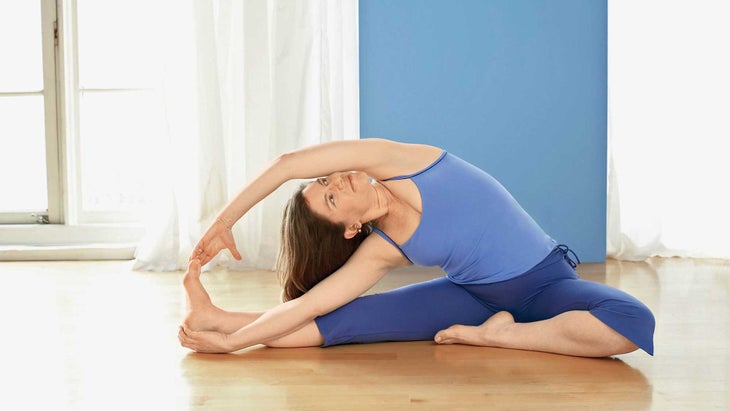Heading out the door? Read this article on the new Outside+ app available now on iOS devices for members! Download the app.

Technically, menopause lasts only 24 hours—it’s the day 12 months after your final period, Brizendine says. But the transition leading up to that significant day can last 10 years. The perimenopause passage usually happens sometime between the ages of 42 and 55, when you go from normal menses to none at all. During this stage, you experience an erratic cycling of estrogen, progesterone, and testosterone that can lead to insomnia, hot flashes, fatigue, PMS, depression, irritability, anxiety, and low libido. “You’d gotten used to your menstrual cycle, and all of a sudden your hormone chemistry changes dramatically,” Brizendine explains.
See also How Yoga Calms Anxiety Holistically
Adapting Your Practice for Perimenopause
Studies show that conscious breathing is a great option for managing perimenopausal symptoms. Simple pranayama with a five-second inhalation and five-second exhalation for 15 minutes twice a day can cut hot flashes by 44 percent, according to a study in Menopause, the journal of the North American Menopause Society. And this is a time to pay close attention to your physical and emotional states and see how your practice affects them. Inversions can relieve stress and insomnia; twists can relieve fatigue and depression; forward bends help ease irritability and anxiety. Many women find that their practice, once aggressive and fast-paced, mellows into one of longer-held, sustained poses.
Real Experience
“Perimenopause can take you into physical and emotional upheaval,” says physician and yoga teacher Sara Gottfried, our model here. Her perimenopause started after the birth of her second child, at age 38. “I have mood swings, and my night sweats worsen with my Ashtanga practice, so I do a more Ana-Forrest-meets-Angela-Farmer style of yoga.” Her center of gravity has changed, and she enjoys arm balances and inversions more now. “My practice is informed by my hormones and emotional context. In my 20s and most of my 30s, I was flexible and on task. Now I focus on survival and regulating my mood, so that I don’t rage at my family. I prevent rage with forward bends and inversions. I prevent depression with backbends and pranayama.”
3 Yoga Poses for Perimenopausal Women
Supported Shoulderstand (Salamba Sarvangasana)

Benefits: Helps relieve stress, mild depression, and menopausal symptoms.
Fold at least two blankets into rectangles and stack them. Put a sticky mat over them to avoid slipping. Lie on the blankets with your legs outstretched, your shoulders supported, and your head on the floor. Bring your arms alongside your body, palms facing down. On an exhalation, bring the knees to the chest and take a few deep breaths. Then press into the floor with your hands and raise the hips off the floor, bringing the arms to your back with the fingertips facing up. With your hands supporting your back, slowly raise your torso so that it comes perpendicular to the floor. Draw your elbows toward each other as you walk your hands on your back toward the floor. As you inhale, lift your bent knees toward the ceiling, bringing your thighs in line with your torso. Lift through the balls of your feet, soften the throat and eyes, and let the shoulder blades move toward your sacrum. Press the backs of your upper arms and the tops of your shoulders actively into the floor, and focus on lifting the spine away from it. Gaze softly at your chest. Stay for 1 minute. To come out, bend your knees to your chest, leave your head on the floor, and roll slowly onto your back.
Revolved Head-of-the-Knee Pose (Parivrtta Janu Sirsasana)

Benefits: Helps with emotional calming during time of intense hormonal shifts.
Start by sitting on the floor with your legs outstretched in Dandasana (Staff Pose). Bend the left leg and bring the sole of the left foot to the inner right thigh. Twist the trunk to the left as you stretch the right arm toward the extended right leg, reaching toward the inner side of the right foot. Bring the left arm overhead and reach toward the right foot, coming into a side stretch. Bring your bottom elbow toward the floor and your top biceps alongside your ear. On the exhalation, gently twist your torso toward the ceiling, bringing your head between your arms. On each exhalation, rotate your torso a bit more toward the ceiling. Stay here for 30 seconds or so. To come out, release your hands and come back to Staff Pose. Then repeat on the other side.
Marichi’s Pose (Marichyasana)

Benefits: Can help manage perimenopausal symptoms like mild depression, hot flashes, and anxiety.
Sit on the floor with your legs outstretched. Bend your left knee and place the sole of the foot flat on the floor with the left heel as close to the left sitting bone as possible. As you twist your torso to the right, bring the left shoulder forward until the left armpit touches the left shin. Leave the arm where it is and unwind the twist and face forward. On an exhalation, turn the left arm around the left shin and thigh, bend the left elbow, and bring the left forearm behind the back at waist level. On an exhalation, swing the right hand behind your back and clasp both hands together. As you exhale, extend your torso forward and lower it toward the extended leg. Relax the shoulders. Stay for 1 minute. To come out, release the arms and extend the left leg. Repeat on the other side.
About the Author
Nora Isaacs, a former editor at Yoga Journal, is the author of Women in Overdrive: Find Balance and Overcome Burnout at Any Age. Learn more about her writing and editing work at noraisaacs.com.